More Injury-Related Survey Results
In my last blog post about the 2019 survey, where I talked about injuries and exercise (HERE), I was surprised to learn that people were more likely to be injured if their exercise regimen was specifically tailored to disc golf. I wanted to see if we could learn what other factors might be driving that counter intuitive (to me) statistic. That is what I will talk about today. I’ll look at a couple of other survey questions to see how they relate to the injury rate.
More Opportunities For Injury
My initial thought was that if a person is so dedicated to disc golf that they would adopt an exercise program specifically for the sport, they would also be attending leagues, tournaments, and throwing more practice rounds than the average disc golfer. Therefore, more opportunities for injury. Let’s see if we can test that hypothesis. First, let’s look again at the general injury rate among all survey participants. That rate is about 19.4%.

Round And Round We Go
Now we can look at other statistics. In the survey we asked how many rounds you threw in a month. According to the results, people who averaged 1-4 rounds per month have an injury rate of 6.5%. That percentage increases with each increase in the number of rounds played, until a slight dip occurs in the 25-30 round/month category. Then, it reaches the highest level with 31+ rounds played. If you play 31+ rounds per month, congratulations on getting so many rounds in! And, statistically speaking, you have an approximately 1 in 4 chance of getting injured. Your chances of getting injured are greater than the average if you play 10 or more rounds per month, . The results are graphed below.
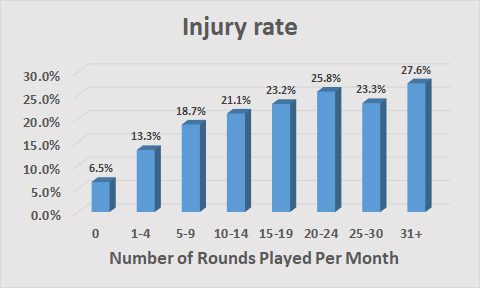
Injuries And Tournament Attendance
Let’s see if tournament attendance follows the same pattern. I’ll present the data in the same format as with the injury rate in the graph above, breaking the category down into the number of tournaments we participated in, versus how many people who played that number of tournaments were injured. That doesn’t mean people were necessarily injured while playing in a tournament. Just that they played in a tournament some time in 2019, and were injured come time that year. I also broke it down into sanctioned and unsanctioned tournaments. Here are those survey results.
According to the survey, tournament attendees don’t increase their chances of getting hurt significantly as they increase the number of tournaments they play. And as an average, the injury rate is 23% for those people who play tournaments, versus 19.4% for all disc golfers. Slightly higher, but not too significant.
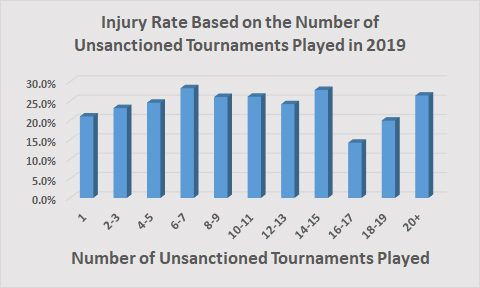
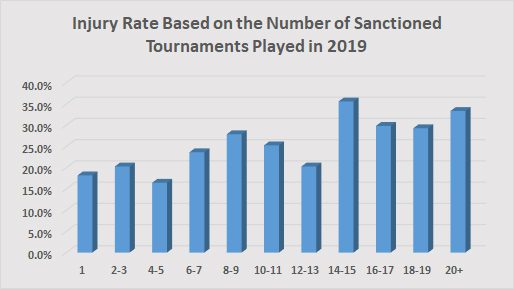
Exercise and Injury
Although there are many factors to show why we would get injured more often when using a fitness routine tailored for disc golf, these survey results at least partially validate the idea that playing more often gives us more opportunities for injury. Countering is the notion that if we are playing more often, we should be in better shape, thus reducing our chances for injury. Despite the survey results in the last blog, I still recommend a fitness and stretching routine that is specifically for disc golf. Since we use such a variety of muscles in our sport, getting in shape for disc golf would make someone in good condition overall.
In addition to examining these statistics about injuries and disc golf, I wanted to reach out to an expert. Seth Munsey of Disc Golf Strong works with the top disc golfers in the world. He has a few thoughts about why we would have a higher injury rate among those of us who exercise specifically for disc golf. His comments lead me to believe that the issue is that people’s definition of ‘exercising specifically for disc golf’. I think when people say that, they are really saying that they exercise with a general fitness routine. If they are in good overalls shape, that will help for disc golf. But, the overall fitness isn’t the same as preparing specifically for disc golf.
Words From a Pro
Seth Munsey said, “There is a big difference in “exercising” and “training.” Many people that exercise do so with the intent of burning calories, feeling the burn, sweating, etc. While it is always a good thing that people are moving and strengthening their bodies, it is entirely different than training for disc golf. Training is exercising with purposeful intent. Exercises are selected and programmed specifically for the demands placed on the disc golfer’s body.”
He concluded by saying, “There are likely other factors at play that we could investigate and discuss, but following a general exercise program and not exercises that are best for disc golf could definitely lead to a higher injury risk.”
One More Thing I Was Curious About
In addition to the things I’ve covered, I thought it might be interesting to see if cart and backpack bag use affecting the injury rate. Do we get injured more often when we continually have to pick up our bags? I would expect a lower injury rate for cart users, and a higher rate among backpack users.
As the charts below show, using a cart doesn’t significantly decrease your chances of getting injured. Interestingly, the survey shows that backpack type bag users are even less likely to get injured. That is not what I would have guessed. Whether or not we get injured depends on many factors. Despite the survey results mentioned in my last blog post, I still recommend a fitness and stretching routine. One specifically for disc golf as the best prevention of injury. Getting in shape for disc golf would make someone in good condition overall.
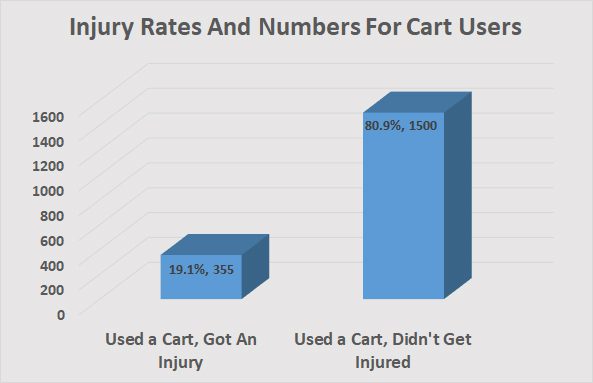
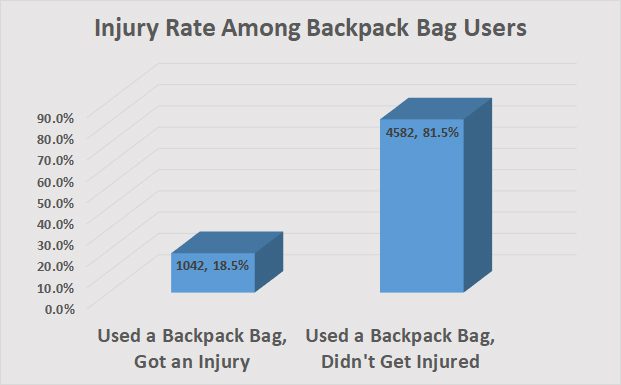
Check out some exercises for disc golf at Disc Golf Strong, HERE

Did you adjust for player’s age when looking at cart vs backpack? In my experience, carts are more common among older players who would be at greater risk for injury. However, carts are less common on extreme terrain where there’s an increased risk of injury.
How about injury type? My right knee hurts after playing four tournament rounds this past weekend, but I didn’t suffer any acute (e.g., slip/trip/fall) injuries – just feels like overuse.